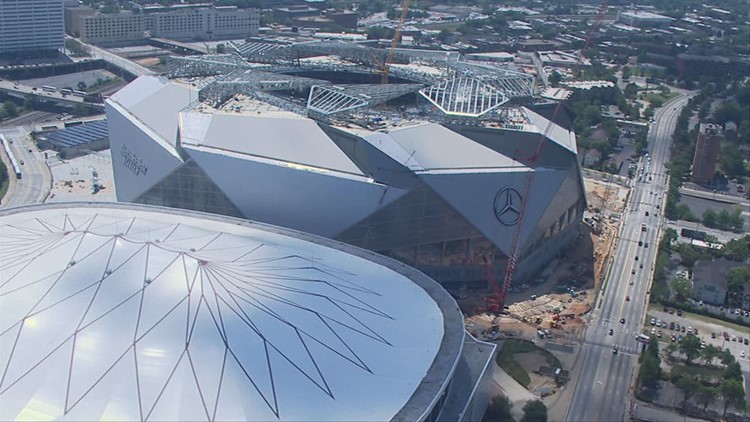ATLANTA -- It's no secret that the roof of Mercedes-Benz Stadium won't be open or fully automated for the stadium's first event in two weeks.
However, stadium officials told 11Alive Sports in an exclusive interview on Tuesday that they purposely delayed its progress so they could finish other parts of the $1.6 billion stadium in time, as well to continue work to expand the longevity of the automation mechanism of the roof.
Mike Egan is the senior vice president and general counsel of AMB Group, which owns Mercedes-Benz Stadium. He acts as the liaison between AMB Group, the Darden & Company, the project management company, and HHRM, the construction company.
Egan explained how the roof is made up of eight panels, each weighing 500 tons, or a total of 4,000 tons of steel, which is all trying to slide open and close. When the mechanism that opens and closes the roof is fully automated, the process will take about 12 minutes. That is more than twice as fast as most retractible roofs in professional sports.
Each panel on the roof slides across two rails. The rails are straight for each panel, but the full effect will make it look like the roof is opening like a camera lens, Bill Darden, president of Darden & Company, explained.
"One rail actually drives the pedal to open and close and the other rail holds it down so it wouldn’t tip over into the bowl," Darden said. "They run just straight even though the the view you have from below or above is that it’s closing like a camera lens. It is massively complicated. The rail system, thank goodness, does not curve. It’s just straight back and forth."
The issue with the roof, which AMB Group told 11Alive in July would not be fully functioning by the stadium's first event on Aug. 26, is ensuring that the weight distribution along each section of the rail is precise to keep the panel level and keep it from wearing down the rails.
"The mechanization is almost like a little locomotive, and you want to get the balance just right because you want to get the roof to be sure you’re not wearing out those pieces before," Egan said. "We got to a point, quite frankly, where we said, you know what, let’s just sit that aside for a little and get everything else in 100 percent tip top shape, and then let’s just come back and work on the fine tuning of the roof afterwards."
Delays with the roof have continued to plague progress of the new stadium opening adjacent to the Georgia Dome, which will be demolished in November. The stadium was originally scheduled to open in March.
The measuring process is extremely intricate and takes a long period of time. Crews have successfully opened and closed the roof four and a half times, according to Darden. They will test it again between the two Falcons exhibition games on Aug. 26 and Aug. 31.
Along each section of the rails, crews are determining if weight needs to be added or reduced from the panels on each side. While the rails are straight, there are dips and hills in them to help balance each panel as it moves. Correct measurements will help the automation mechanism last for years to come.
"All the work we’re doing now, it has nothing to do with the safety of the roof. This is all about the lifespan of the-- it’s a complicated and expensive mechanism that moves the roof," Egan said.
Currently, it takes eight different people to control the movement of each panel as it moves. Manually, it's down to four hours to open or close the roof. Eventually, all eight panels will be programed so they can be controlled by one button that will open the roof in just over 10 minutes.
Once all of that is done, the roof will be fully functioning. Stadium officials believe that will be this fall. They're promising open air Falcons and Atlanta United FC games this season.
Egan is adamant that any remaining work they're doing on the roof will not compromise the safety of the stadium.
"The last thing we would do is take any compromise in safety. This will be the most safe and secure building in professional sports," he said.
However, he's not sure if future stadiums will try and take on a roof like that of Mercedes-Benz Stadium because of its complexity. Other features like the "halo" video board, which is the size of a five-story office building and hangs below the ceiling, he believes stadiums will emulate.
"I’m not sure anyone will go about that roof because it is so complicated. I think it will be a one of a kind. I don’t think people will take that challenge on for awhile," Darden said.
The NFL was inside the stadium on Tuesday and making stadiums officials and staff go through a dress rehearsal of an actual game day.
Other than a little bit of cleaning and dusting, and the roof, the stadium is complete.
"We’re ready. We’re absolutely ready," Egan said. "[Fans] will not feel like they’re walking into a building that’s incomplete or not ready. They’re going to be blown away."



